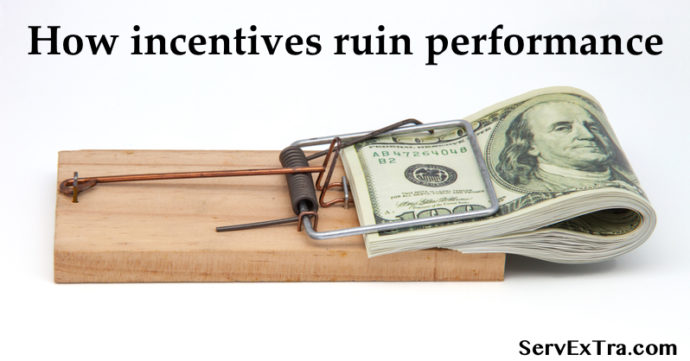Blog
How incentives ruin performance
By Todd Liles • How incentives ruin performance
The wrong incentive program will ruin a service tech’s performance. Spiffs, Commissions, and Free vacations can create a dangerously short-sighted system that actually reduces overall results.
Incentives are not the problem. The problem exists in the short-sightedness of the program, and not understanding your people. Let me give you an example:
A Good Incentive with Terrible Results
All HVAC Techs are fully aware of the phase out of HFC-22 “R-22” from the US and Global markets. In contrast, most techs have never heard of HFC-23 “R-23.”
R-23 is a byproduct refrigerant that is created during the production of R-22, and it is nasty!
As a greenhouse gas, R-23 has 11,700 times more global warming potential than CO2 (carbon dioxide). That’s bad news for the environment.
In an international effort, incentives were created for manufactures to properly destroy the R-23 byproduct. The incentive was a “carbon credit” that they could use for their own production plant, or sell to other production plants for a profit.
Notice that I said the incentive was to destroy R-23, not reduce the production of R-23.
Can you guess what happened?
Some scrupulous business owners figure out that they could actually make an additional $20 million per year if they cranked up R-22 production. With an increase in R-22, they could create more R-23, and they could make more money. This was all during the time of the R-22 phase out.
The end result? A complete backfire. A good idea produced terrible results.
FREE DOWNLOAD – HVAC What You Need to Know
Can an Incentive Program Backfire in Your Company?
The quick answer is “Of course!”
Sales Lead Incentive Program Disaster
In an effort to increase Sales Leads, one of my consulting clients offered a $75 spiff for any lead turned over, and an additional $75 if it sold. Admittedly, I supported the program.
The results?
The company generated more sales leads then the previous month. This would seem to suggest the incentive worked. But did it?
Sadly no, the incentive did not work. In fact, it was a terrible disaster. Here’s why; while leads were way up, overall closing percentages were way down. This caused a morale issue with the selling techs and comfort advisors. This carried over into the good leads as well. The end results was less replacement sales as a whole.
Can you guess why?
Much like the manufacturing plant that was incentivized for producing a terrible product, so were service techs for flipping unqualified leads.
In the mind of the service tech, “The only rule is that I flip a lead. If it doesn’t sell, so what. I still get 75 bucks.” If you are service tech, before you write me a nasty email, or blast me on social media, just ask yourself this question:
“If the company put that program in place, why wouldn’t I take advantage of it?”
RELATED – Maintaining the Ethics of Commissioned Based Service Techs
Other disastrous programs
Other companies have made similar mistakes in different ways.
Take the company that wants to increase IAQ sales. While IAQ has a huge benefit, it can also serve as a big distraction to other areas of the business.
Imagine that a tech gets a $75 incentive for selling a UV light. The light may take 10 minutes to sell, and 20 minutes to install. Let’s say that this tech can sell this light 1 out of 4 offers. So, that’s an added $75 a day! That’s great.
Hold on, let’s look at the other effects. Now that the tech is focused on selling IAQ, his service agreement numbers and leads have gone down.
For the tech, that’s not a big deal. The $75 spiff for leads has been removed, and Service Agreements only net him $10. He would have to sell 7.5 more service agreements than UV Bulbs.
You may be thinking, why doesn’t he do it all?
Good question. Some techs will do it all, but most techs will sell what they focus on. It’s the Law of the Path of Least Resistance.
So, Do Incentives Actually Work?
Yes. Incentives work, and they work very well. Again, incentives are not the problem. The problem is whether or not you have developed the proper incentive.
Good Incentives Operate on the Following Principles
- Create Results with Minimum Negative Impact. Think…setting more leads that are qualified, as opposed to setting leads no matter what.
- Be Attractive but not Seductive. An incentive has to be attractive enough that your people will want it, and not so seductive that they will do unethical things to get it!
- Have Consequences that are as Painful as the Rewards are Beneficial. Any system without law will turn to chaos. You must have an enforcer of the laws in your company. Without an owner, manager, or leader enforcing the moral and ethical code of an organization, you can be sure that your incentives will generate a negative result.
Any company can implement the 3 principles above. By thinking through the long term effect of your incentive program, you can develop a tremendous system that is endorsed by the plumber, hvac tech, or electrician.
Question: What does the service industry need to do to develop better incentives? Please comment and share on Facebook and LinkedIn.
What SETs Us Apart?
Proactive Business Plans
A proactive business is a successful business. That's why our team takes the time to make sure every client has a proactive, not reactive, business plan. Our strategies make your business run more smoothly and profitable.
Proven Results
Our training services help businesses identify and achieve their key performance indicators (KPIs). Whether it's increased revenue or higher satisfaction rates, our methods allow you to see immediate and continued results.
Personalized Training
Our team of experts works hard to make sure your business gets personalized training. We'll work with your team one-on-one or in group settings to set and achieve your business goals. We develop training based on your goals!
Prioritizing People
We believe that people are the most valuable asset. We strive to provide outstanding benefits, life balance, leadership, and support to our team. We believe in helping people reach their greatest level of growth, contribution and satisfaction.

Trusted By
Business Ignition
SPARK
Classroom Training
Resources
Company

Join our newsletter











